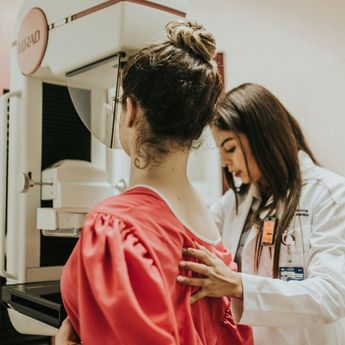By continuing to use our site, you consent to the processing of cookies, user data (location information, type and version of the OS, the type and version of the browser, the type of device and the resolution of its screen, the source of where the user came from, from which site or for what advertisement, language OS and Browser, which pages are opened and to which buttons the user presses, ip-address) for the purpose of site functioning, retargeting and statistical surveys and reviews. If you do not want your data to be processed, please leave the site.
The Voice of People With Breast Cancer
Information
Breast Cancer Basics
Understanding Risk Factors
Fixed Risk Factors
There are some risks for developing breast cancer that you cannot change. These are called non-modifiable risk factors.
Age
Age is the most significant risk factor for breast cancer. Most breast cancers are diagnosed in people over the age of 50, and risk increases as you get older.
Female Sex
People assigned female at birth account for over 99% of breast cancer cases. This higher risk is largely due to lifelong exposure to the hormones estrogen and progesterone, which can encourage tumour growth.
Family History
Having a first-degree relative (parent, sibling, or child) with breast cancer—especially if diagnosed before age 50—increases your risk. The more affected relatives you have, the higher your risk. Family history may also reflect shared lifestyle or environmental exposures.
Inherited Genetic Mutations
Around 5–10% of breast cancers are linked to inherited gene mutations. The most well-known are BRCA1 and BRCA2, but others like PALB2, TP53, ATM, and CHEK2 can also raise risk. These mutations can be passed from either parent - even if they’ve never had cancer.
If you have a personal or family history of breast cancer, you may want to consider genetic testing to see if you carry one of these mutations.
Race and Ethnicity
Race and ethnicity can affect breast cancer risk, subtype, and outcomes. White people have the highest overall incidence, while Black people are more often diagnosed younger, with more aggressive cancers, and face higher mortality rates. These disparities are influenced by tumour biology, access to care, social conditions, and systemic inequities.
Related reading from Our Voices Blog:
Reproductive History
Your lifetime exposure to estrogen and progesterone can influence your breast cancer risk. You may be at increased risk if you:
- Started your period before age 12
- Went through menopause after age 55
- Have never given birth or had your first child after age 30
These factors are linked to a longer duration of hormone exposure.
Personal History of Breast or Ovarian Conditions
If you've had breast cancer before, you’re at higher risk of developing a new cancer in either breast. Benign breast conditions—especially atypical hyperplasia, lobular carcinoma in-situ (LCIS), and other conditions where cells grow abnormally—also raise risk, particularly when combined with family history.
Previous Radiation Therapy
People who received radiation therapy to the chest at a young age—often to treat conditions like Hodgkin lymphoma—have a higher risk of developing breast cancer later in life.
Dense Breasts
Breast density refers to the amount of fibrous and glandular tissue compared to fatty tissue in the breast. It can’t be felt or seen—only a mammogram can determine it. Nearly half of women aged 40 and older have dense breasts. Read more about dense breasts here.
Medical Review by Roochi Arora, MD, FRCPC, August 2025.
- References
-
American Cancer Society. (2021). Breast cancer risk factors you cannot change. https://www.cancer.org/cancer/types/breast-cancer/risk-and-prevention/breast-cancer-risk-factors-you-cannot-change.html
Canadian Breast Cancer Network. (2022). Breast cancer and you: A guide for people living with breast cancer [PDF]. https://cbcn.ca/web/default/files/public/
Reports/Breast%20Cancer%20and%20You_
ENG_edit_web.pdfCanadian Cancer Society. (2024). Breast density. https://cancer.ca/en/treatments/tests-and-procedures/mammography/breast-density
Canadian Cancer Society. (n.d.). Risks for breast cancer. https://cancer.ca/en/cancer-information/cancer-types/breast/risks
Chlebowski, R. T., Chen, Z., Anderson, G. L., Rohan, T., Aragaki, A., Lane, D., Dolan, N. C., Paskett, E. D., McTiernan, A., Hubbell, F. A., Adams-Campbell, L. L., & Prentice, R. (2005). Ethnicity and breast cancer: Factors influencing differences in incidence and outcome. Journal of the National Cancer Institute, 97(6), 439–448. https://doi.org/10.1093/jnci/dji064Fiolet, T., Srour, B., Sellem, L., Kesse-Guyot, E., Allès, B., Méjean, C., Deschasaux, M., Fassier, P., Latino-Martel, P., Beslay, M., Hercberg, S., Lavalette, C., Monteiro, C. A., Julia, C., & Touvier, M. (2018). Consumption of ultra-processed foods and cancer risk: results from NutriNet-Santé prospective cohort. BMJ (Clinical research ed.), 360, k322. https://doi.org/10.1136/bmj.k322
Public Health Agency of Canada. (2023). Breast cancer and your risk. Government of Canada. https://www.canada.ca/en/public-health/services/chronic-diseases/breast-cancer-your-risk.html
Susan G. Komen. (2024). Breast cancer risk factors: Age. https://www.komen.org/breast-cancer/risk-factor/age/
Susan G. Komen. (2025). Race and ethnicity and breast cancer risk. https://www.komen.org/breast-cancer/risk-factor/race-ethnicity/
Łukasiewicz, S., Czeczelewski, M., Forma, A., Baj, J., Sitarz, R., & Stanisławek, A. (2021). Breast cancer-Epidemiology, risk factors, classification, prognostic markers, and current treatment strategies-An updated review. Cancers, 13(17), 4287. https://doi.org/10.3390/cancers13174287
Canadian Cancer Society. (n.d.). Breast cancer Statistics. https://cancer.ca/en/cancer-information/cancer-types/breast/statistics
SHARE




